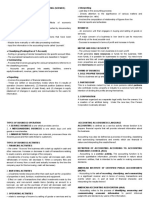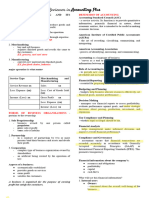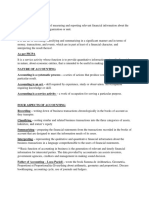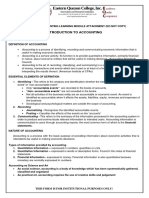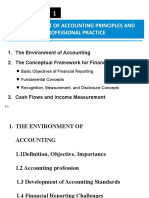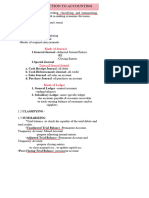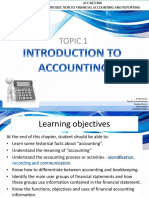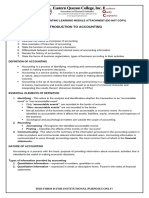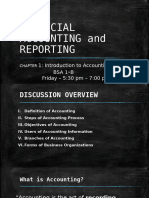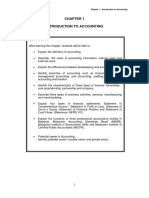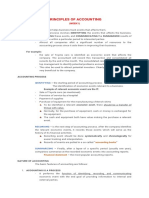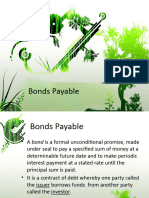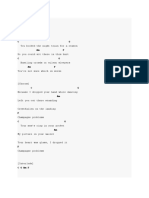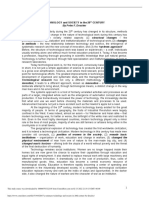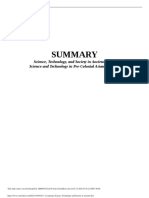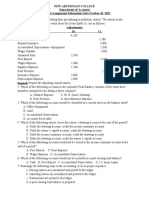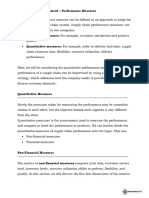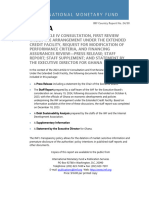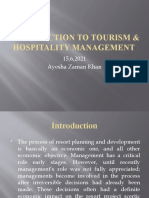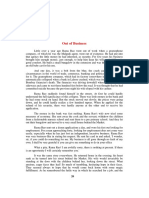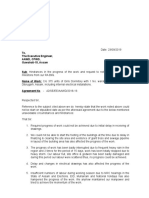Chapter 1
Chapter 1
Uploaded by
Mikaela LacabaCopyright:
Available Formats
Chapter 1
Chapter 1
Uploaded by
Mikaela LacabaOriginal Title
Copyright
Available Formats
Share this document
Did you find this document useful?
Is this content inappropriate?
Copyright:
Available Formats
Chapter 1
Chapter 1
Uploaded by
Mikaela LacabaCopyright:
Available Formats
fundamentals of
accounting [FUNDAMENTAL CONCEPTS AND PRINCIPLES]
DEFINITION OF ACCOUNTING needs of the users
4) INTERPRETING
•Accounting is the systematic
-to speak/act/define/represent
process of measuring and reporting
the qualitative and quantitative
relevant financial information about
information about the business
the activities of an economic
transactions in a language
organization or unit.
comprehensible to the users of
•(AICPA) The art of recording, the FS
classifying, and summarizing in a -through this, users are able to
significant manner under terms of determine the financial standing
money, transactions and events, of the company, its stability, and
which are in part at least of a growth potential
financial character, and interpreting -they use this for specific
the results thereof. business decisions
-this aspect of accounting shows
•(PICPA) Accounting is a service us that accounting is the
activity. Its function is to provide language of business
quantitative information, primarily
financial in nature, about economic
entities, that is intended to be useful
in making economic decisions. USERS OF FINANCIAL
INFORMATION/PARTIES
FOUR ASPECTS OF ACCOUNTING
INTERESTED IN FINANCIAL
1) RECORDING INFORMATION
-writing down of business
transactions chronologically in 1) INVESTORS/OWNERS/STOCKHOLDERS
the books of account as they -They provide the financial
transpire/happen resources to keep the business
2) CLASSIFYING running. They need the financial
-sorting similar and related information to decide whether to
business transactions into three invest or not. This all depends on
categories: ASSETS, LIABILITIES, the estimated amount of income on
OWNER’S EQUITY their investment.
3) SUMMARIZING
-preparing financial statements 2) GOVERNMENT
based in the previously recorded -For tax purposes and Securities
transactions in the books of and Exchange Commission (SEC)
account to meet the information requirements.
fundamentals of
accounting [FUNDAMENTAL CONCEPTS AND PRINCIPLES]
One Person Corporation is
a corporation with a
3) FINANCIAL INSTITUTIONS/ single stockholder, who must be a
CREDITORS natural person, trust, or an estate.
-To determine the capacity of the It must not be confused with
organization to pay its obligations a corporation sole. The creation of a
on time. One Person Corporation or OPC is
provided in Title XIII (Special
4) MANAGEMENT Corporations) of Republic Act No.
-To set goals for the organization, 11232, also known as the “Revised
evaluate the progress, and use it as Corporation Code”. The guidelines,
a guide for future management as provided in SEC Memorandum
actions or decisions. Circular No. 7, series of 2019.
5) EMPLOYEES THREE TYPES OF BUSINESS
-For employees to determine if they OPERATIONS
have a future in the company
(company stability). 1) SERVICE – a business operation
engaged in the rendering of services
Examples: dental clinic, barber shop,
THREE TYPES OF BUSINESS laundry services, business services,
ORGANIZATION fitness facilities, hospitals, hotel &
1) SOLE PROPRIETORSHIP lodging
-Owned and managed by only one 2) TRADING/MERCHANDISING
person - a business operation engaged in
2) PARTNERSHIP buying and selling goods
-Owned and managed by two or -involved in the purchasing and
more people who agree to contribute converting of raw materials to
money, property or industry to a finished goods
common fund for the purpose of Examples: grocery, sari-sari store
earning a profit 3) MANUFACTURING – business
3) CORPORATION operation engaged in the production
-Managed by an elected board of of items to be sold
directors -involved in the purchasing and
-Unit of ownership is called “share converting of raw materials to
of stock”; investors are stockholders finished goods
•One Person Corporation Examples: shoe factory, food
processing
fundamentals of
accounting [FUNDAMENTAL CONCEPTS AND PRINCIPLES]
1. ENTITY CONCEPT
•Many companies engage in more •the business enterprise is separate
than one type of bus. ops. They run and distinct from its owners
different departments or divisions 2. PERIODICITY
for different purposes. •the concept behind providing
EXAMPLES financial accounting information
about the economic activities of an
-TECH COMPANY produces phones enterprise for specified time periods
(MANUFACTURING) and then sells •one year is usually considered as
them through distribution centers one accounting period
(MERCHANDISING) then also Types of Accounting Periods
provides repairs & maintenance a) CALENDAR YEAR
(SERVICE) -starts on January 1 and
ends on December 31
-RESTAURANT combines
b) FISCAL YEAR
ingredients in making a meal
-starts on any month and
(MANUFACTURING) and also
ends twelve months after
provides a dining venue (SERVICE)
•NATURAL BUSINESS YEAR
and sell bottles of beverage
-any twelve-month period that
(MERCHANDISING)
ends when business activities
are at their lowest point
GENERALLY ACCEPTED 3. GOING CONCERN
ACCOUNTING PRINCIPLES (GAAP) •assumes that the enterprise will
continue to operate indefinitely
•broad, general statements or
“rules” and “procedures” that serve
as guides in the accounting practice BASIC PRINCIPLES
1) OBJECTIVITY PRINCIPLE
•standards, assumptions, and
•all business transactions
concepts with general acceptability
must be duly supported by
•measurement techniques and verifiable evidence
standards used in the presentation •official receipts, deposit slips
and preparation of financial 2) HISTORICAL COST
statements •all properties and services
acquired by the business
must be recorded at its
original acquisition cost
FUNDAMENTAL CONCEPTS
fundamentals of
accounting [FUNDAMENTAL CONCEPTS AND PRINCIPLES]
3) ACCRUAL PRINCIPLE
•income is recognized at the
time it is earned, expenses are
recognized at the time they
are incurred (when they are
actually used and not when
they are payed)
4) ADEQUATE DISCLOSURE
•all material facts that will
significantly affect the
financial statements must be
indicated
•for example, if something was
purchased, it should be
recorded at its historical cost
but the current market value
may be included/indicated on
the FS (footnote/parenthetical)
5) MATERIALITY
•financial reporting must only
be concerned with information
significant enough to affect
decisions
6) CONSISTENCY
•approaches used in reporting
must be uniformly employed
or used from period to period
to allow comparison of results
between time periods (changes
must be clearly explained)
You might also like
- Basic of Accounting Principles PDFDocument23 pagesBasic of Accounting Principles PDFMani KandanNo ratings yet
- BAC 813 - Financial Accounting Premium Notes - Elab Notes LibraryDocument111 pagesBAC 813 - Financial Accounting Premium Notes - Elab Notes LibraryWachirajaneNo ratings yet
- FABM ReviewerDocument17 pagesFABM ReviewerKyle Kyle67% (3)
- External Users: Not Directly Involved. These Are Secondary Users of Financial Information Who Are PartiesDocument8 pagesExternal Users: Not Directly Involved. These Are Secondary Users of Financial Information Who Are PartiesAizel AlindoyNo ratings yet
- Case 01 Buffett 2015 F1769Document36 pagesCase 01 Buffett 2015 F1769Josie KomiNo ratings yet
- Engineering Economic Analysis - Review: University of TorontoDocument25 pagesEngineering Economic Analysis - Review: University of TorontoHaiderNo ratings yet
- Trane Air Conditioning Manual Part-1Document28 pagesTrane Air Conditioning Manual Part-1Briana Jenkins60% (10)
- Far 1 Accounting For Partnership Corporation Midterms Review CompressDocument12 pagesFar 1 Accounting For Partnership Corporation Midterms Review CompressBuhia, Alexandra DeniceNo ratings yet
- ACCOUTINGDocument3 pagesACCOUTINGMae SheNo ratings yet
- AccountingDocument10 pagesAccountingRodver Angelo EsperaNo ratings yet
- Internal External: Prepared by M.T. SacramedDocument2 pagesInternal External: Prepared by M.T. SacramedLawrence CasullaNo ratings yet
- Review On Fundamentals of AccountingDocument18 pagesReview On Fundamentals of AccountingFat AjummaNo ratings yet
- REVIEWER ACCOUNTING TUTORIAL Chapter 1-4Document20 pagesREVIEWER ACCOUNTING TUTORIAL Chapter 1-4bae joohyunNo ratings yet
- 20150908170923introductory AccountingDocument11 pages20150908170923introductory AccountingShine CshNo ratings yet
- Chapter 1 - Introduction To Cost & Management AccountingDocument30 pagesChapter 1 - Introduction To Cost & Management AccountingJiajia Mox100% (1)
- Chap 1-4Document20 pagesChap 1-4Rose Ann Robante TubioNo ratings yet
- Ais P1Document55 pagesAis P1cali cdNo ratings yet
- FABM 1 ReviewerDocument2 pagesFABM 1 ReviewerClaire BulagaoNo ratings yet
- Basic ConceptsDocument5 pagesBasic ConceptsAgatha ApolinarioNo ratings yet
- Far ReviewerDocument10 pagesFar Reviewercyven4817No ratings yet
- ACCOUNTING REVIEWERDocument7 pagesACCOUNTING REVIEWERtrishatenebro7No ratings yet
- Fundamentals of AccountingDocument26 pagesFundamentals of AccountingSofia Naraine OnilongoNo ratings yet
- Entrep Group 9Document124 pagesEntrep Group 9Elizabeth VillarealNo ratings yet
- Accounting and Its EnvironmentDocument27 pagesAccounting and Its EnvironmentMarta MeaNo ratings yet
- Tutorial Chapter 1 Hand OutDocument3 pagesTutorial Chapter 1 Hand OutKarysse Arielle Noel JalaoNo ratings yet
- Introduction To Accounting - Chapter 1Document33 pagesIntroduction To Accounting - Chapter 1Kendricks MapaloNo ratings yet
- Topic 2 Regulatory and Conceptual FrameworkDocument15 pagesTopic 2 Regulatory and Conceptual FrameworkfeyNo ratings yet
- FABM NotesDocument6 pagesFABM Notesdanie.hermosaNo ratings yet
- What Is AccountingDocument3 pagesWhat Is AccountingEmmanuel James SevillaNo ratings yet
- FAr NotesDocument7 pagesFAr NotesmartgetaliaNo ratings yet
- Accounting Notes: Unit 1 Video 1 & 2Document2 pagesAccounting Notes: Unit 1 Video 1 & 2liandra espinosaNo ratings yet
- IjjjDocument6 pagesIjjjRegine CariñoNo ratings yet
- Chapter-1-Financial AccountingDocument85 pagesChapter-1-Financial AccountingHabesh FilmsNo ratings yet
- Accounting 1Document11 pagesAccounting 1Gniese Stephanie Gallema AlsayNo ratings yet
- CFAS Easy To Learn (Conceptual Framework)Document61 pagesCFAS Easy To Learn (Conceptual Framework)Borg Camlan100% (1)
- Lecture - 1 - Accounting - in - Business - NUS ACC1002 2020 Spring PostDocument42 pagesLecture - 1 - Accounting - in - Business - NUS ACC1002 2020 Spring PostZenyui100% (1)
- Business and Accounting REVIEWERDocument8 pagesBusiness and Accounting REVIEWERMoon 7044No ratings yet
- Acc407 - 406 Chapter 1 Introduction To AccountingDocument17 pagesAcc407 - 406 Chapter 1 Introduction To AccountingNurul Fatimah PajarNo ratings yet
- Niat ReviewerDocument2 pagesNiat ReviewerMae leeNo ratings yet
- Integrated AccountingDocument4 pagesIntegrated AccountingJennilou Añasco100% (1)
- Financial AccountingDocument3 pagesFinancial AccountingJaimee CruzNo ratings yet
- Integrated Accounting Module 1Document7 pagesIntegrated Accounting Module 1Mary Rose AmolarNo ratings yet
- Basic Accounting Principles ModuleDocument23 pagesBasic Accounting Principles ModulezendeexNo ratings yet
- FAR-INTRODUCTION-TO-ACCOUNTING-BSA-1BDocument23 pagesFAR-INTRODUCTION-TO-ACCOUNTING-BSA-1BmykellandreihabladoNo ratings yet
- BusfinanzDocument4 pagesBusfinanzfrancine ًNo ratings yet
- Chapter 1 Introduction To AcctgDocument11 pagesChapter 1 Introduction To AcctgNUR ANIS SYAMIMI BINTI MUSTAFA / UPMNo ratings yet
- Accounting Concepts An PrinciplesDocument3 pagesAccounting Concepts An PrinciplesDanica QuinacmanNo ratings yet
- Far ReviewerDocument10 pagesFar Reviewercyven4817No ratings yet
- REVIEWERDocument12 pagesREVIEWEREva Mae LabardaNo ratings yet
- ACCCOB2 Introduction To Financial Accounting PPT T1AY2223-1Document25 pagesACCCOB2 Introduction To Financial Accounting PPT T1AY2223-1Clement ChuaNo ratings yet
- Mark Edzon A. Bello: ACCY 101 - Fundamentals of Accounting Notre Dame of Marbel UniversityDocument26 pagesMark Edzon A. Bello: ACCY 101 - Fundamentals of Accounting Notre Dame of Marbel UniversityAngel Grace Asuncion0% (1)
- Basic Accounting Lesson 1 LectureDocument7 pagesBasic Accounting Lesson 1 LectureNorlyn DiestaNo ratings yet
- CHAPTER 1 (Lecture Notes)Document20 pagesCHAPTER 1 (Lecture Notes)Nor Farhanah NanaNo ratings yet
- AccountingDocument6 pagesAccountingJanine MargarethNo ratings yet
- Accounting ReviewerDocument12 pagesAccounting Reviewerveggiebites2023No ratings yet
- Fundamentals of AccountingDocument11 pagesFundamentals of AccountingJacob DiazNo ratings yet
- Notes AcctgDocument7 pagesNotes AcctgMc RamosNo ratings yet
- 1.1 Intro To SCM and Management AccountingDocument6 pages1.1 Intro To SCM and Management AccountingXyril MañagoNo ratings yet
- Basic Accounting Crash CourseDocument5 pagesBasic Accounting Crash CourseCyra Jimenez100% (1)
- Principles of AccountingDocument11 pagesPrinciples of AccountingFariza YscondidoNo ratings yet
- "The Language of Business: How Accounting Tells Your Story" "A Comprehensive Guide to Understanding, Interpreting, and Leveraging Financial Statements for Personal and Professional Success"From Everand"The Language of Business: How Accounting Tells Your Story" "A Comprehensive Guide to Understanding, Interpreting, and Leveraging Financial Statements for Personal and Professional Success"No ratings yet
- Bonds PayableDocument114 pagesBonds PayableMikaela LacabaNo ratings yet
- Financial Ratios Problemswith AnswersDocument17 pagesFinancial Ratios Problemswith AnswersMikaela LacabaNo ratings yet
- Bachelor of Science in Accountancy SubjectsDocument3 pagesBachelor of Science in Accountancy SubjectsMikaela LacabaNo ratings yet
- BREAKEVENDocument3 pagesBREAKEVENMikaela LacabaNo ratings yet
- Financial Ratio Analysis-RatiosDocument3 pagesFinancial Ratio Analysis-RatiosMikaela LacabaNo ratings yet
- Champagne ProblemsDocument4 pagesChampagne ProblemsMikaela LacabaNo ratings yet
- Chapter 2Document9 pagesChapter 2Mikaela LacabaNo ratings yet
- AGAINDocument2 pagesAGAINMikaela LacabaNo ratings yet
- AFTERGLOWDocument4 pagesAFTERGLOWMikaela LacabaNo ratings yet
- Jim Latzko Webinar Handout - Portable Faith 1.5Document8 pagesJim Latzko Webinar Handout - Portable Faith 1.5Mikaela LacabaNo ratings yet
- Jim Latzko Webinar Handout - Digital World Missions-OutlineDocument2 pagesJim Latzko Webinar Handout - Digital World Missions-OutlineMikaela LacabaNo ratings yet
- 1.7.a Summary Technology and Society in 20th Century by DrucDocument5 pages1.7.a Summary Technology and Society in 20th Century by DrucMikaela LacabaNo ratings yet
- 1.1 1.2 Summary Science Technology and Society in AncientDocument5 pages1.1 1.2 Summary Science Technology and Society in AncientMikaela LacabaNo ratings yet
- Individual Assignment.123Document5 pagesIndividual Assignment.123Tsegaye BubamoNo ratings yet
- Make or Buy Decision and Value EngineeringDocument9 pagesMake or Buy Decision and Value EngineeringSangivikumar SNo ratings yet
- Contract Assuptions: Revenue Capital (BRL) Daily Rental Revenue Monthly Rental RevenueDocument61 pagesContract Assuptions: Revenue Capital (BRL) Daily Rental Revenue Monthly Rental RevenueRobertoVitorianoNo ratings yet
- Case Study Adc AnswerDocument2 pagesCase Study Adc AnswerLêMinhAnh100% (1)
- LME Group Fees and Charges 2020 JulyDocument22 pagesLME Group Fees and Charges 2020 JulyAndrea SotoNo ratings yet
- Impact of COVID-19 On BusinessDocument3 pagesImpact of COVID-19 On BusinessHasan Rabbi100% (4)
- Practical Res 1Document33 pagesPractical Res 1neil licatanNo ratings yet
- DreamconDocument17 pagesDreamconKen SuryadiNo ratings yet
- 2022 Gr12 Telematics-HistoryDocument24 pages2022 Gr12 Telematics-Historyjoshybratz2018No ratings yet
- Week 8.1 Performance Measures in SCMDocument5 pagesWeek 8.1 Performance Measures in SCMAzure AuroraNo ratings yet
- Annual Report 2019Document179 pagesAnnual Report 2019Ankit SinghNo ratings yet
- IMF GHANA REPORT January 2023Document155 pagesIMF GHANA REPORT January 2023The Independent Ghana100% (2)
- Edge Feb9Document24 pagesEdge Feb9bearteddy17193No ratings yet
- 1x40Mtr Foot BridgeDocument5 pages1x40Mtr Foot Bridgehakim imtiyazNo ratings yet
- Aluminum PriceDocument4 pagesAluminum PriceJayesh BaldotaNo ratings yet
- Introduction To Tourism & Hospitality Management: 15,6,2021 Ayesha Zaman KhanDocument17 pagesIntroduction To Tourism & Hospitality Management: 15,6,2021 Ayesha Zaman KhanAyesha Zaman KhanNo ratings yet
- Argument EssayDocument3 pagesArgument EssayMikhael RudyNo ratings yet
- Group 8 - Routes To GlobalizationDocument42 pagesGroup 8 - Routes To Globalizationjeane Fuentes100% (1)
- MCQ's On EconomicsDocument43 pagesMCQ's On Economicsआई सी एस इंस्टीट्यूटNo ratings yet
- DXBJW Guest Folio52637321Document2 pagesDXBJW Guest Folio52637321saied.ae90No ratings yet
- Recovering Unnoticed Ideas. On The English Translation of Bernardo DavanzatiDocument5 pagesRecovering Unnoticed Ideas. On The English Translation of Bernardo DavanzatiBenito Sovero SotoNo ratings yet
- Out of BusinessDocument6 pagesOut of BusinessArijit Das50% (2)
- List of Executive Committee PDFDocument2 pagesList of Executive Committee PDFNilesh Suvrna KawadeNo ratings yet
- Sequential Games of Perfect Information UPFDocument58 pagesSequential Games of Perfect Information UPFirisyun02No ratings yet
- Acjc 2021 H2 Ec P2Document3 pagesAcjc 2021 H2 Ec P2anonymous wheatsNo ratings yet
- Literature ReviewDocument26 pagesLiterature ReviewShahid ShaikhNo ratings yet
- JNV Moran Letter For HinderanceDocument2 pagesJNV Moran Letter For Hinderancesumanjit dasNo ratings yet











